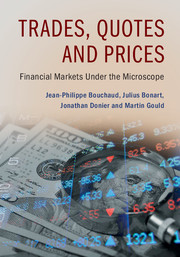Book contents
- Frontmatter
- Dedication
- Contents
- Preface
- Acknowledgements
- PART I HOW AND WHY DO PRICES MOVE?
- PART II LIMIT ORDER BOOKS: INTRODUCTION
- PART III LIMIT ORDER BOOKS: MODELS
- PART IV CLUSTERING AND CORRELATIONS
- PART V PRICE IMPACT
- PART VI MARKET DYNAMICS AT THE MICRO-SCALE
- PART VII ADVERSE SELECTION AND LIQUIDITY PROVISION
- PART VIII MARKET DYNAMICS AT THE MESO-SCALE
- 18 Latent Liquidity and Walrasian Auctions
- 19 Impact Dynamics in a Continuous-Time Double Auction
- 20 The Information Content of Prices
- PART IX PRACTICAL CONSEQUENCES
- Appendix
- Index
- References
20 - The Information Content of Prices
from PART VIII - MARKET DYNAMICS AT THE MESO-SCALE
Published online by Cambridge University Press: 26 February 2018
- Frontmatter
- Dedication
- Contents
- Preface
- Acknowledgements
- PART I HOW AND WHY DO PRICES MOVE?
- PART II LIMIT ORDER BOOKS: INTRODUCTION
- PART III LIMIT ORDER BOOKS: MODELS
- PART IV CLUSTERING AND CORRELATIONS
- PART V PRICE IMPACT
- PART VI MARKET DYNAMICS AT THE MICRO-SCALE
- PART VII ADVERSE SELECTION AND LIQUIDITY PROVISION
- PART VIII MARKET DYNAMICS AT THE MESO-SCALE
- 18 Latent Liquidity and Walrasian Auctions
- 19 Impact Dynamics in a Continuous-Time Double Auction
- 20 The Information Content of Prices
- PART IX PRACTICAL CONSEQUENCES
- Appendix
- Index
- References
Summary
Most, probably, of our decisions to do something positive, the full consequences of which will be drawn out over many days to come, can only be taken as the result of animal spirits – a spontaneous urge to action rather than inaction, and not as the outcome of a weighted average of quantitative benefits multiplied by quantitative probabilities.
(John Maynard Keynes)After our deep-dive into the microstructural foundations of price dynamics, the time is ripe to return to one of the most important (and one of the most contentious!) questions in financial economics: what information is contained in prices and price moves? This question has surfaced in various shapes and forms throughout the book, and we feel that it is important to devote a full chapter to summarise and clarify the issues at stake. We briefly touched on some of these points in Section 2.3. Now that we have a better handle on how markets really work at the micro-scale, we return to address this topic in detail.
The Efficient-Market View
Traditionally, market prices are regarded to reflect the fundamental value (of a stock, currency, commodity, etc.), up to small and short-lived mispricings. In this way, a financial market is regarded as a measurement apparatus that aggregates all private estimates of an asset's true (but hidden) value and, after a quick and efficient digestion process, provides an output price. In this view, private estimates should only evolve because of the release of a new piece of information that objectively changes the value of the asset. Prices are then martingales because (by definition) new information cannot be anticipated or predicted. In this context, neither microstructural effects nor the process of trading itself can affect prices, except perhaps on very short time scales, due to discretisation effects like the tick size.
Major Puzzles
This Platonian view of markets is fraught with a wide range of difficulties that have been the subject of thousands of academic papers in the last 30 years (including those with renewed insights from the perspective of market microstructure). The most well known of these puzzles are:
• The excess-trading puzzle: If prices really reflect value and are unpredictable, why are there still so many people obstinately trying to eke out profits from trading? […]
- Type
- Chapter
- Information
- Trades, Quotes and PricesFinancial Markets Under the Microscope, pp. 366 - 380Publisher: Cambridge University PressPrint publication year: 2018

